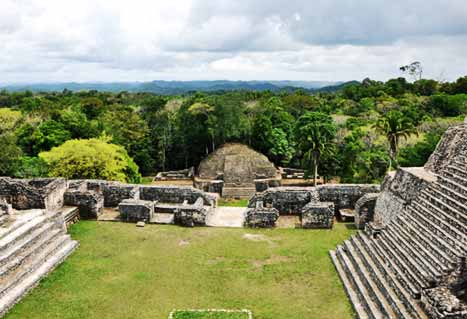A high-resolution climate record spanning 2,000 years shows how Maya political systems developed and fell apart in response to climate change, researchers report.
The role of climate change in the development and demise of classic Maya civilization, ranging from AD 300 to 1000, has been controversial for decades because of a lack of well-dated climate and archaeological evidence.
In an article published today in Science, the researchers outline how they reconstructed rainfall records from stalagmite samples collected from Yok Balum Cave, located nearly three miles from ancient city of Uxbenka, in the tropical Maya Lowlands in southern Belize.

"Here you had an amazing state-level society that had created calendars, magnificent architecture, works of art, and was engaged in trade throughout Central America,” says anthropology professor and co-author Bruce Winterhalder. "They were incredible craftspersons, proficient in agriculture, statesmanship, and warfare—and within about 80 years, it fell completely apart." (Credit: Douglas Kennett/Penn State)
They compared their findings to the rich political histories carved on stone monuments at Maya cities throughout the region.
“Every one of these Maya monuments is political history,” says linguist Martha Macri, a professor of Native American studies at UC Davis.
Inscribed on each monument is the date it was erected and dates of significant events, such as a ruler’s birthday or accession to power, as well as dates of some deaths, burials and major battles. The researchers noted that the number of monuments carved decreased in the years leading to the collapse.
“Unusually high amounts of rainfall favored an increase in food production and an explosion in the population between AD 450 and 660,” says Douglas Kennett, lead author and professor of anthropology at Penn State.
“This led to the proliferation of cities like Tikal, Copan, and Caracol across the Maya lowlands. The new climate data show that this salubrious period was followed by a general drying trend lasting four centuries that was punctuated by a series of major droughts that triggered a decline in agricultural productivity and contributed to societal fragmentation and political collapse.
“The most severe drought (AD 1020 and 1100) in the record occurs after the widespread collapse of Maya state centers (referred to as the Maya collapse) and may be associated with widespread population decline in the region.”
Over the centuries, according to Kennett, the cities suffered a decline in their populations and Maya kings lost their power and influence.
“The linkage between an extended 16th century drought, crop failures, death, famine, and migration in Mexico provides a historic analog, supported by the cave stalagmite samples, for the socio-political tragedy and human suffering experienced periodically by the Classic Period Maya,” he says.
“Here you had an amazing state-level society that had created calendars, magnificent architecture, works of art, and was engaged in trade throughout Central America,” says University of California, Davis, anthropology professor and co-author Bruce Winterhalder. “They were incredible craftspersons, proficient in agriculture, statesmanship, and warfare—and within about 80 years, it fell completely apart.”
The rich archaeological and historical records of the Maya provide an opportunity to examine the long-term effects of climate change for both the development and disintegration of complex sociopolitical systems like our own, notes Kennett, an expert on the human effects of global climate change and the environmental impacts of expanding populations.
“The effects of climate change are complex and play out over multiple time scales,” he says. “Abrupt climate change is only part of the story. In addition to climate drying and drought, the preceding conditions stimulating societal complexity and population expansion helped set the stage for later stress on their societies and the fragmentation of political institutions.”
“It has long been suspected that weather events can cause a lot of political unrest and subject societies to disease and invasion,” Macri says. “But now it’s clear. There is physical evidence that correlates right along with it. We are dependent on climatological events that are beyond our control.”
Winterhalder says: “It’s a cautionary tale about how fragile our political structure might be. Are we in danger the same way the Classic Maya were in danger? I don’t know. But I suspect that just before their rapid descent and disappearance, Maya political elites were quite confident about their achievements.”
The study’s other co-authors are from Eidgenössische Technische Hochschule Zürich, Zurich, Switzerland; University of New Mexico; National Institute of Culture and History, Belize; University of Durham, UK; University of Oregon; Penn State; University of California, Davis; Potsdam Institute for Climate Impact Research, Germany; and University of Durham.
The National Science Foundation, European Research Council, Swiss National Science Foundation, German Science Foundation, and the Alphawood Foundation funded the study.

















